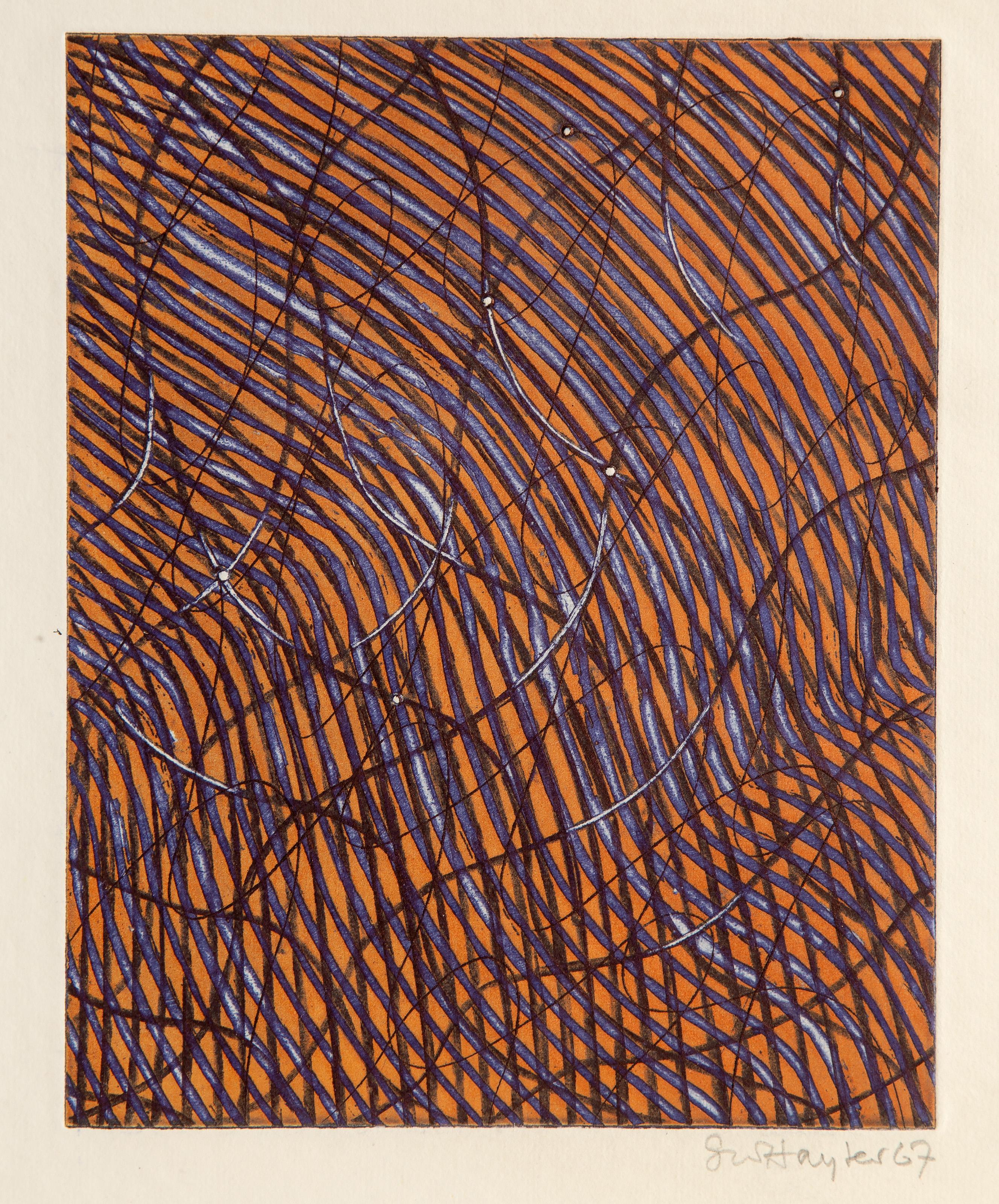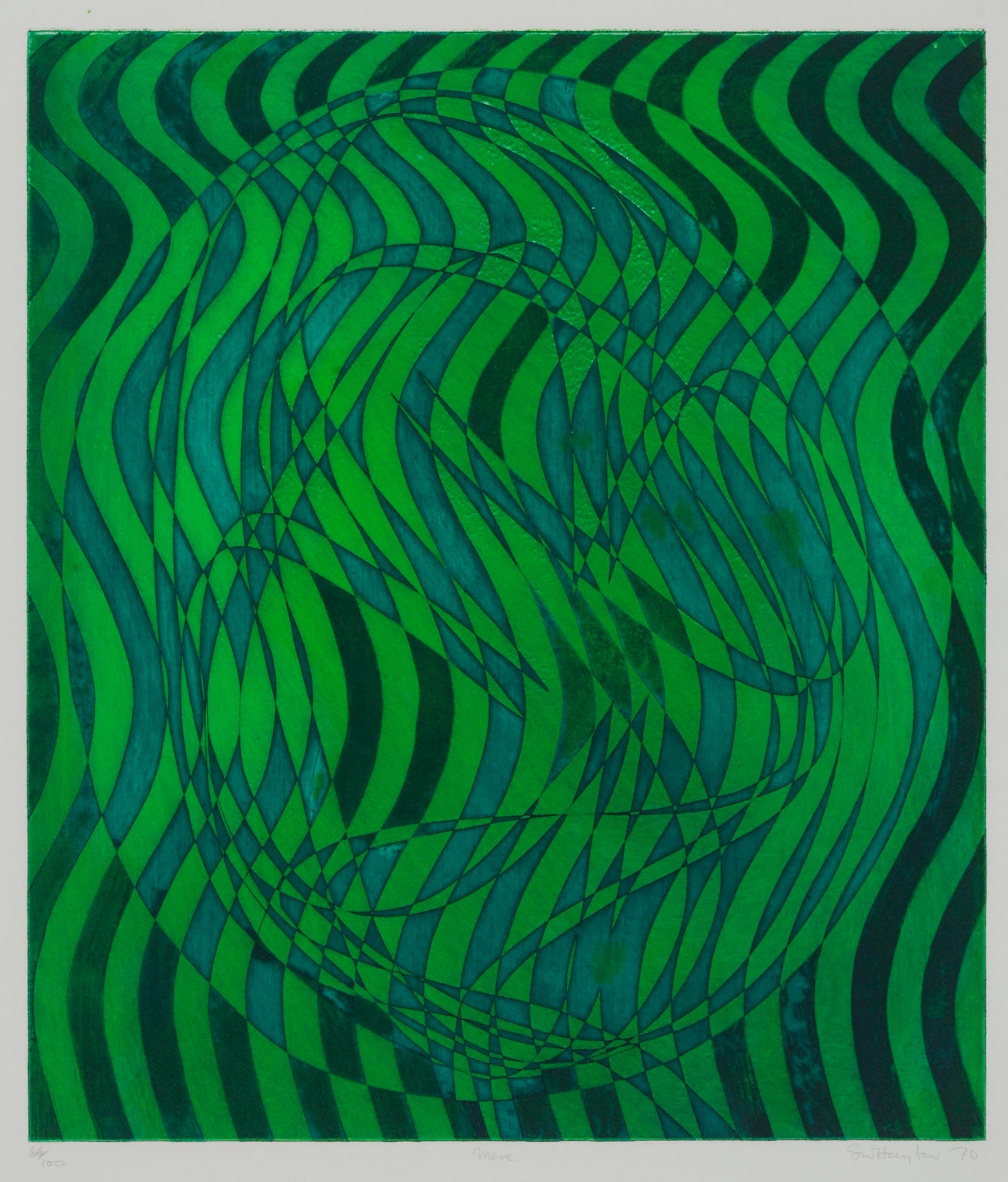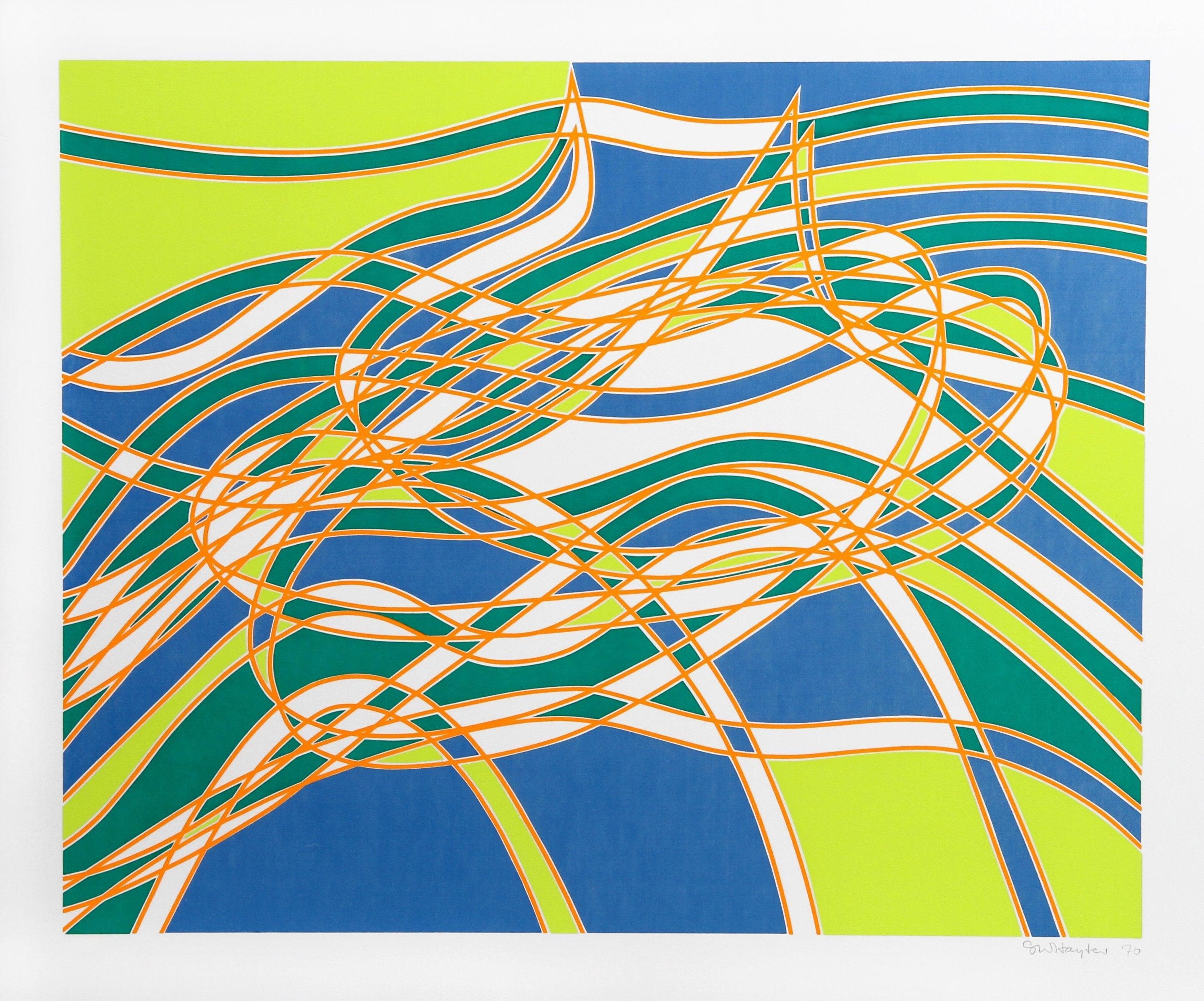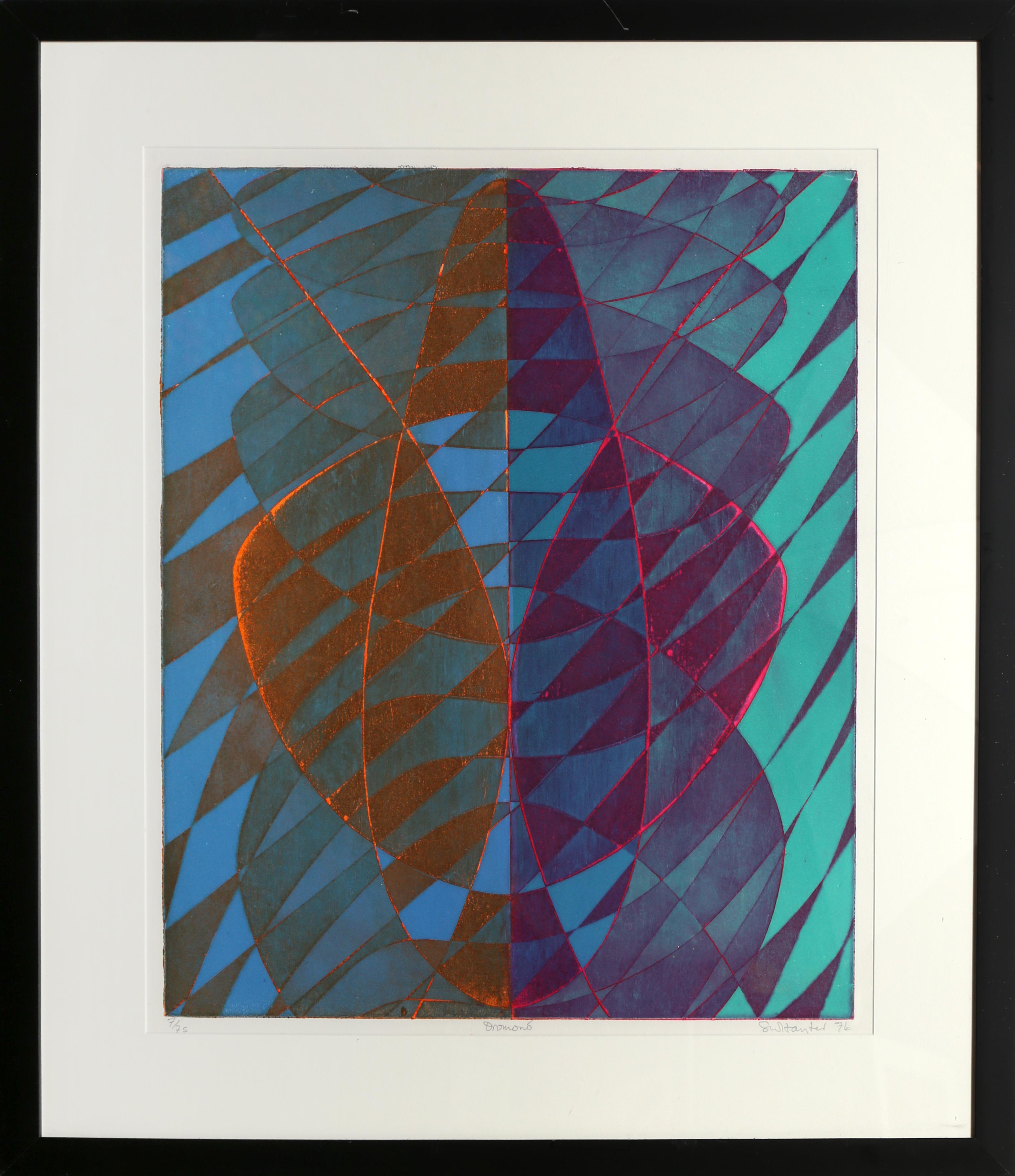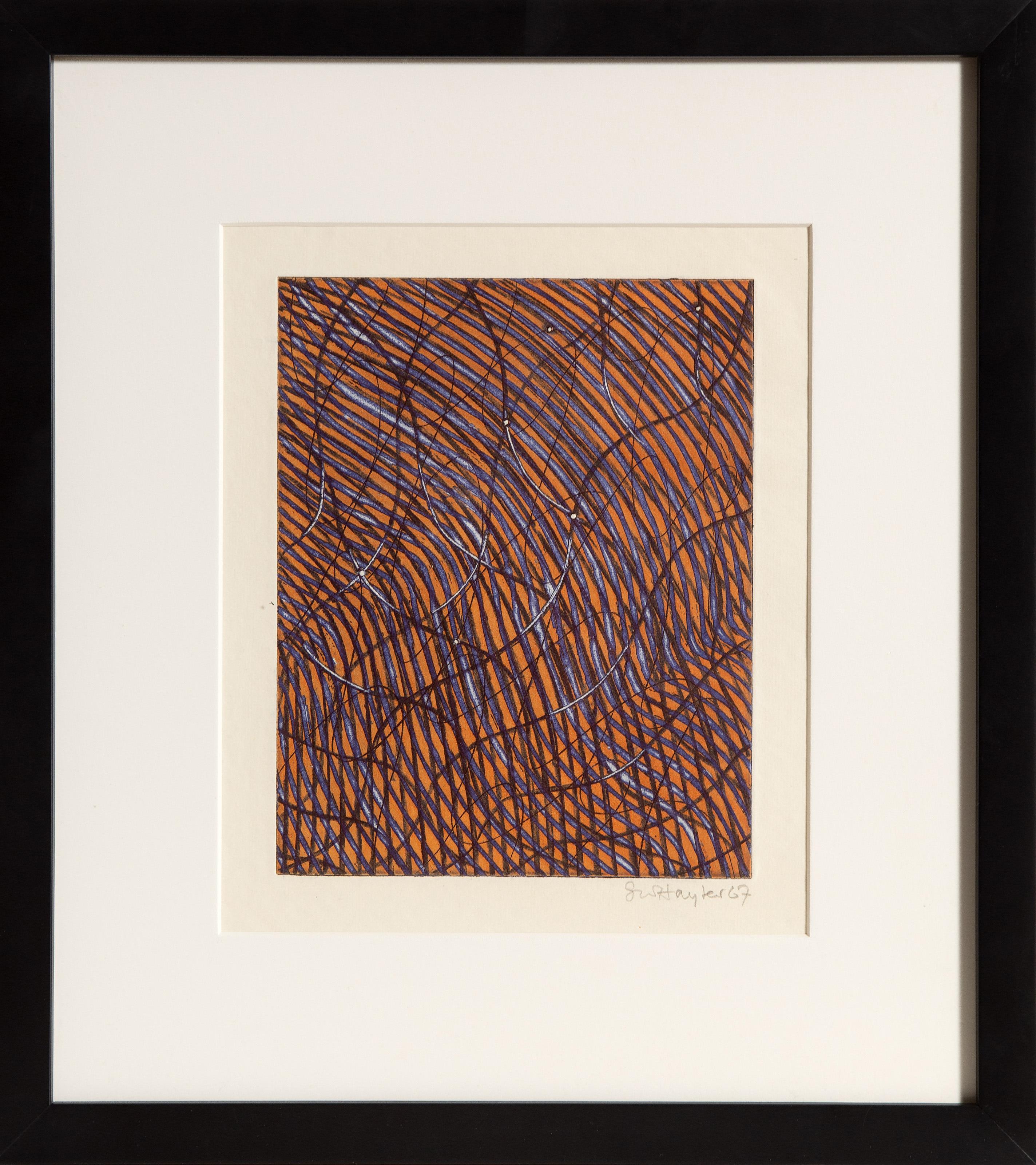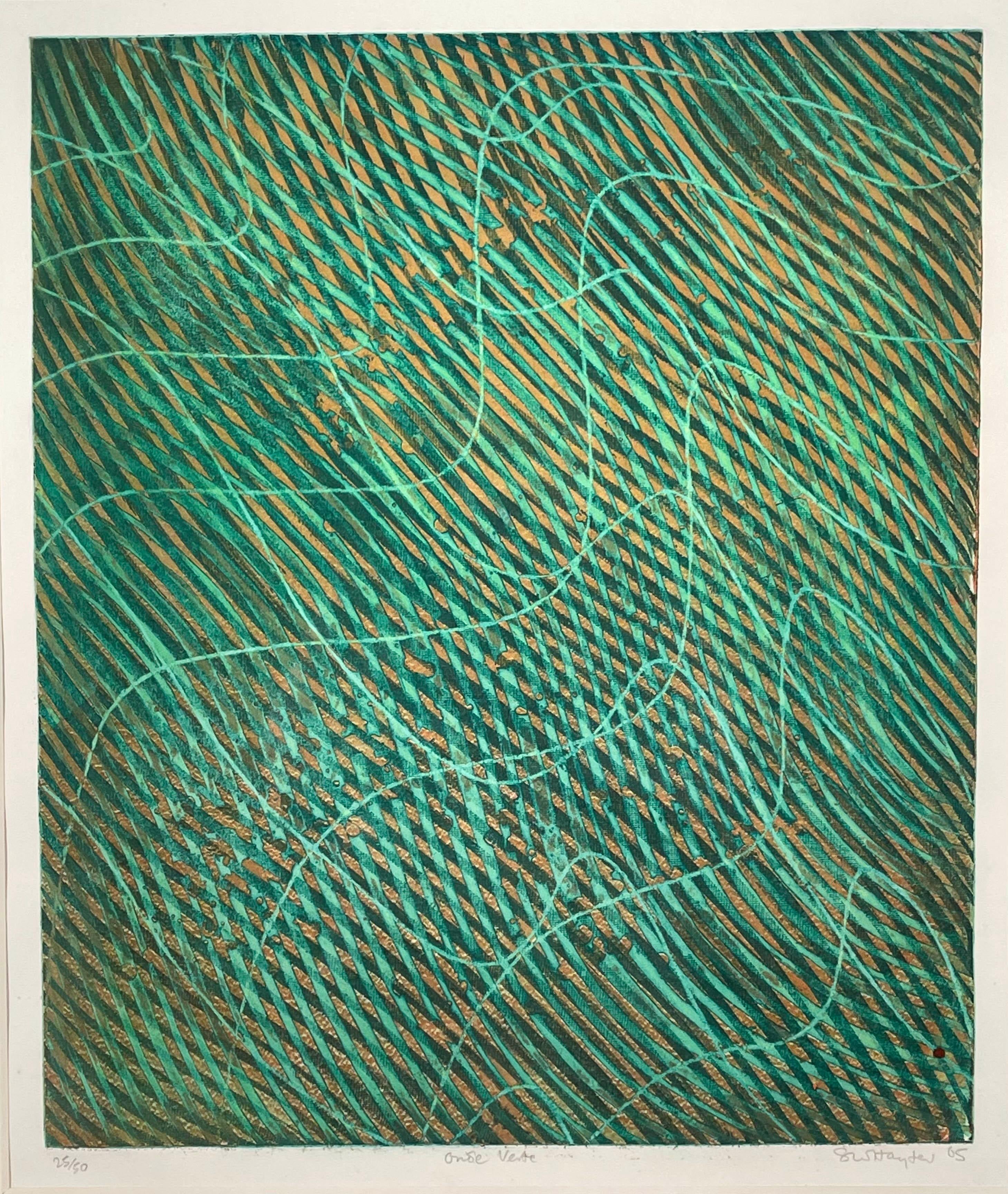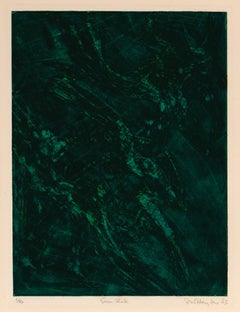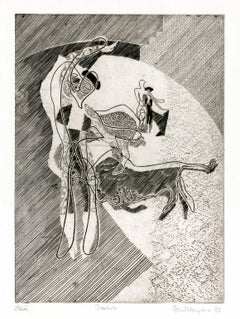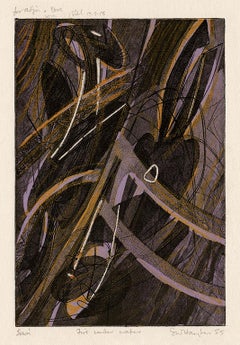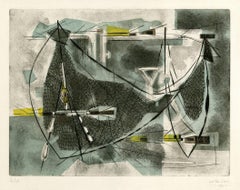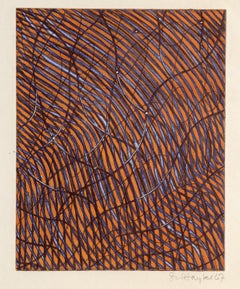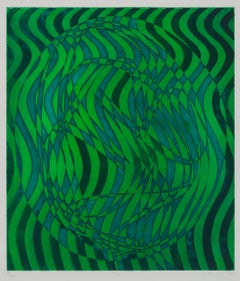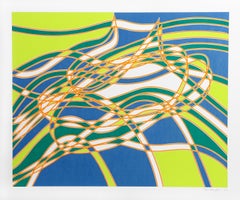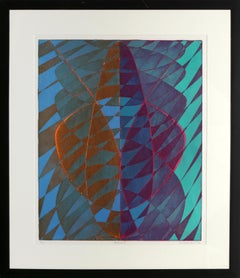Items Similar to 'Diptych' — Modernist Abstraction, Atelier 17
Want more images or videos?
Request additional images or videos from the seller
1 of 7
Stanley William Hayter'Diptych' — Modernist Abstraction, Atelier 171967
1967
$1,500
£1,164.36
€1,320.75
CA$2,141.76
A$2,360.05
CHF 1,224.12
MX$28,069.59
NOK 15,484.74
SEK 14,505.92
DKK 9,864.03
About the Item
Stanley William Hayter, 'Diptych', color engraving and scorper, 1967, edition 50, Black & Moorhead 314. Signed, titled, dated, and numbered '10/50' in pencil. A superb, richly-inked impression, with fresh, vibrant colors on antique-white wove BFK Rives paper; the full sheet with margins (2 1/2 to 3 1/4 inches). Minor skinning and tape residue on the top and bottom sheet edges, verso, otherwise in excellent condition. Matted to museum standards, unframed.
Image size 13 7/8 x 19 1/2 inches (146 x 108 mm); sheet size 19 7/8 x 25 3/8 inches (394 x 292 mm).
Hayter created this work using engraving and scorper on 2 plates, printed side by side. He used alkali blue, printed intaglio, and a phthalo green with a hard roller on the surface. The proofing was in three states, the first with engraving (a single proof); the second adding further engraving and scorper (a single proof); the third added further engraving and editioned: color trial proofs, 5 artist's proofs, edition of 50. The edition was completed in three printings: 8 in 1967; then Hector Saunier printed numbers 9 through 18 in 1968, and numbers 19 through 50 in 1969. This impression is from the Saunier 1968 printing.
Note: the online image cannot accurately convey the vibrancy of the printed alkali blue/phthalo green.
An impression of this work is held in the collection of the National Gallery of Art.
ABOUT THE ARTIST
Stanley William Hayter (1901-1988) was a British painter and printmaker associated in the 1930s with Surrealism and from 1940 onward with Abstract Expressionism. Regarded as one of the most significant printmakers of the 20th century, Hayter founded the legendary Atelier 17 studio in Paris, now known as Atelier Contrepoint. Among the artists he is credited with influencing are Pablo Picasso, Alberto Giacometti, Joan Miró, Alexander Calder, and Marc Chagall.
The hallmark of the workshop was its egalitarian structure, breaking sharply with the traditional French engraving studios by insisting on a cooperative approach to labor and technical discoveries. In 1929 Hayter was introduced to Surrealism by Yves Tanguy and André Masson, who, with other Surrealists, worked with Hayter at Atelier 17. The often violent imagery of Hayter’s Surrealist period was stimulated in part by his passionate response to the Spanish Civil War and the rise of Fascism. He organized portfolios of graphic works to raise funds for the Spanish cause, including Solidarité (Paris, 1938), a portfolio of seven prints, one of them by Picasso. Hayter frequently exhibited with the Surrealists during the 1930s but left the movement when Paul Eluard was expelled. Eluard’s poem Facile Proie (1939) was written in response to a set of Hayter’s engravings. Other writers with whom Hayter collaborated in this way included Samuel Beckett and Georges Hugnet.
Hayter joined the exile of the Parisian avant-garde in 1939, moving with his second wife, the American sculptor Helen Phillips, to New York. He ran a course entitled ‘Atelier 17’ at the New School for Social Research until 1945 when he opened the workshop independently in Greenwich Village at 41 East 8th Street. Important figures in the emerging New York School associated with Hayter included Jackson Pollock, Robert Motherwell, Willem de Kooning, Mark Rothko, William Baziotes, and David Smith.
By 1946 Atelier 17 was operating independently in expanded and more versatile facilities. Engagements and temporary appointments kept Hayter traveling all over the country. In 1949 he published 'New Ways of Gravure', a book that included a short history of intaglio techniques and a description of the experiments and achievements of Atelier 17. In 1950 Hayter returned to Europe and reestablished Atelier 17 in Paris. Without him, the New York shop began a steady decline until its closing in 1955, whereas in Paris, the studio flourished.
Throughout the 1980s, Hayter continued to work with his customary drive and openness, consistently responding to currents of style and technique, eventually gravitating back to painting. In 1987, with the purchase of four hundred prints ranging in date from 1926 through 1960, the British Museum became the largest repository of Hayter’s work. When the artist died in London on May 4, 1988, work was underway on a major retrospective of his prints at the Ashmolean Museum at Oxford.
Hayter's graphic work is today included in almost every major 20th-century printmaking museum collection throughout the United States, the UK, and Europe, including The Art Institute of Chicago, Bibliothèque nationale de France (Paris), British Museum, Centre Pompidou (Paris), Harvard Art Museum, Hunterian Museum (University of Glasgow), Hyogo Prefectural Museum of Art (Kobe, Japan), Guggenheim Museum, Los Angeles County Museum of Art, Metropolitan Museum of Art, Museum of Fine Arts Boston, Museum of Modern Art, Musée d’Art Moderne de la Ville, (Paris), National Gallery of Art, Peggy Guggenheim Museum (Venice), Philadelphia Museum of Art, Royal Academy of Art (London), San Francisco Museum of Modern Art, Smithsonian American Art Museum, Tate Modern (London), Victoria & Albert Museum (London), Whitney Museum of American Art, Yale University Art Gallery.
- Creator:Stanley William Hayter (1901-1988, British)
- Creation Year:1967
- Dimensions:Height: 13.88 in (35.26 cm)Width: 19 in (48.26 cm)
- Medium:
- Movement & Style:
- Period:
- Condition:
- Gallery Location:Myrtle Beach, SC
- Reference Number:Seller: 1013511stDibs: LU532312419762
Stanley William Hayter
Stanley William Hayter was an exponent of the surrealism in the 1930s, who turned to abstract expressionism in the 1940s. He is known as one of the most important print makers of the 20th century, and is know to have championed abstract expressionism in printmaking, through his studio and art school, Atelier 17. Hayter's works are in the collections of almost every modern art museums in the world, including the MoMA, the Whitney, the Guggenheim, Tate Modern, and Centre Pompidou.
About the Seller
5.0
Recognized Seller
These prestigious sellers are industry leaders and represent the highest echelon for item quality and design.
Platinum Seller
Premium sellers with a 4.7+ rating and 24-hour response times
Established in 1995
1stDibs seller since 2016
330 sales on 1stDibs
Typical response time: 1 hour
Associations
International Fine Print Dealers Association
- ShippingRetrieving quote...Shipping from: Myrtle Beach, SC
- Return Policy
More From This Seller
View All'Green Shade' — Mid-century Modernism, Abstract Expressionism, Atelier 17
By Stanley William Hayter
Located in Myrtle Beach, SC
Stanley William Hayter, 'Green Shade', color etching and scraper, 1963, edition 50, (only 39 printed), B&M 278. Signed, titled, dated, and numbered '1/50' in pencil. A superb, richly-inked, luminous impression, with fresh, vivid colors, on Barcham Green textured cream wove paper; the full sheet with margins (2 3/16 to 3 1/4 inches), in excellent condition. Printed: intaglio black-green, contact lumogen yellow, soft roller phthalo green. Scarce.
Image size 15 7/16 x 11 5/8 inches (392 x 295 mm); sheet size 21 1/8 x 16 inches (537 x 406 mm). Matted to museum standards (unframed).
Collection: The British Museum
ABOUT THE ARTIST
Stanley William Hayter (1901-1988) was a British painter and printmaker associated in the 1930s with Surrealism and from 1940 onward with Abstract Expressionism. Regarded as one of the most significant printmakers of the 20th century, Hayter founded the legendary Atelier 17...
Category
1960s Abstract Expressionist Abstract Prints
Materials
Etching
'Torero' — rare, early modernist engraving – Atelier 17
By Stanley William Hayter
Located in Myrtle Beach, SC
Stanley William Hayter, 'Torero', engraving, 1932, edition 30, only 16 known impressions, trial proof, Black & Moorhead 71. Signed, titled, dated, and inscribed 'Essai' (test) in pencil. A superb impression with rich burr, on heavy BFK Rives cream, wove paper; full margins (2 1/4 to 6 1/4 inches). A short repaired tear (3/8 inch) in the left-center sheet edge, well away from the image; otherwise, in excellent condition. Scarce.
Image size 10 9/16 x 7 5/8 inches; sheet size 15 1/2 x 11 1/2 inches. Matted to museum standards, unframed.
ABOUT THE ARTIST
Stanley William Hayter (1901-1988) was a British painter and printmaker associated in the 1930s with Surrealism and from 1940 onward with Abstract Expressionism. Regarded as one of the most significant printmakers of the 20th century, Hayter founded the legendary Atelier 17...
Category
1930s Modern Abstract Prints
Materials
Engraving
'Feu sous L'eau' (Fire Under Water) —Mid-century Modernism, Atelier 17
By Stanley William Hayter
Located in Myrtle Beach, SC
Stanley William Hayter, 'Feu sous L'eau (Fire Under Water)', color engraving, soft-ground etching and scorper with yellow silkscreen, 1955, edition 50 plus 10 artist proofs, Black & Moorhead 221. Signed, titled 'Fire Under Water', dated and annotated 'Essai' in pencil. Dedicated in the artist’s hand 'for Adja & Dove WH Bill 17–5–55' in the top margin. A superb, richly inked impression with fresh colors, on heavy, cream wove paper; wide margins (2 1/2 to 3 7/8 inches), in excellent condition. One of 10 artist’s proofs. Image size 10 3/16 x 7 inches; sheet size 18 1/8 x 12 1/4 inches. Matted to museum standards, unframed.
ABOUT THIS WORK
In 1950 Hayter returned to Paris and reopened Atelier 17. Works such as 'Fire Under Water' reveal newfound influences, such as that of the Ardèche area of southern France, where he acquired a house in 1951 and frequently visited. Hayter took great interest in the flowing Escoutay River, an experience that parallels the artist and co-director of Atelier 17 Krishna Reddy’s interest in depicting water. While some forms in this print evoke the natural world, the palette of contrasting tones of purple, yellow, black, and white reflects Hayter’s belief in using color intuitively to express emotions and evoke feelings. The sharp white relief lines from the paper and the textural effects realized through soft-ground etching operate in tandem with the sweeping curves and bold colors to give the composition a sense of vitality and dynamism.
—edited from the Metropolitan Museum of Art
Published by 'La Jeune Gravure Contemporaine', Paris.
Impressions of this work are in the following collections: British Museum, Metropolitan Museum of Art, National Gallery of Art.
ABOUT THE ARTIST
Stanley William Hayter (1901-1988) was a British painter and printmaker associated in the 1930s with Surrealism and from 1940 onward with Abstract Expressionism. Regarded as one of the most significant printmakers of the 20th century, Hayter founded the legendary Atelier 17 studio in Paris, now known as Atelier Contrepoint. Among the artists he is credited with influencing are Pablo Picasso, Alberto Giacometti, Joan Miró, Alexander Calder, and Marc Chagall.
The hallmark of the workshop was its egalitarian structure, breaking sharply with the traditional French engraving studios by insisting on a cooperative approach to labor and technical discoveries. In 1929 Hayter was introduced to Surrealism by Yves Tanguy and André Masson, who, with other Surrealists, worked with Hayter at Atelier 17. The often violent imagery of Hayter’s Surrealist period was stimulated in part by his passionate response to the Spanish Civil War and the rise of Fascism. He organized portfolios of graphic works to raise funds for the Spanish cause, including Solidarité (Paris, 1938), a portfolio of seven prints, one of them by Picasso. Hayter frequently exhibited with the Surrealists during the 1930s but left the movement when Paul Eluard was expelled. Eluard’s poem Facile Proie (1939) was written in response to a set of Hayter’s engravings. Other writers with whom Hayter collaborated included Samuel Beckett and Georges Hugnet.
Hayter joined the exile of the Parisian avant-garde in 1939, moving with his second wife, the American sculptor Helen Phillips...
Category
1950s Abstract Expressionist Abstract Prints
Materials
Engraving, Etching
Nets – Mid-Century Modernism, Atelier 17
By Sigismond Kolos-Vari
Located in Myrtle Beach, SC
Sigismond Kolos-Vari, 'Nets', color etching with soft-ground and aquatint, edition 200 (1 of 60 artist's proofs), 1952. Signed and dated in pencil. Numbered L/LX in pencil. A superb, richly-inked impression, on heavy, off-white, Arches wove paper; the full sheet with margins (1 3/8 to 3 1/2 inches), in excellent condition. Published by the Guide de la Gravure, Switzerland, with their blindstamp in the bottom left sheet corner. Matted to museum standards, unframed.
Image size 11 3/4 x 15 5/8 inches (298 x 397 mm); sheet size 15 x 22 1/4 inches (381 x 565 mm).
ABOUT THE ARTIST
Sigismund Kolos-Vari was born in Hungary and attended the School of Applied Arts in Budapest from 1915 to 1918 and then the School of Decorative Arts until 1925. The artist settled in Paris, and his first one-person show in 1928 at Galerie Miromesnil, which was highly successful, led to numerous subsequent exhibitions, including with the prestigious Galerie Bonaparte in 1929 and Galerie Povolosky in 1930.
Kolos-Vari’s early success was abruptly interrupted by the outbreak of WWII when he was arrested by the Gestapo and imprisoned in the Gurs internment camp. During this period, he created a sketchbook for a little girl, which is now preserved at the Centre de Documentation Juive Contemporaine at the Mémorial de la Shoah in Paris. He managed to escape after two years, crossing the border into Switzerland. After the war, he returned to Paris with a renewed dedication to his painting, producing increasingly powerful compositions. His work was highly acclaimed when shown at an important 1946 exhibition at the Musée National d’Art Moderne de Paris, organized by Jean Cassou. The artist was then approached by the eminent art dealer Jean Bucher, who gave Kolos-Vary a major one-person show at his gallery in 1948. During this post-war period, Kolos-Vary participated in the radical Salon de Mai, 1949-1958, the Salon des Réalités Nouvelles, 1956-1961, and the Salon des Comparaisons, 1960-1962.
Supported by his association with Stanley William Hayter and the landmark printmaking workshop Atelier 17...
Category
Mid-20th Century Abstract Expressionist Abstract Prints
Materials
Etching, Aquatint
'Sylvan Maze' — Mid-century American Surrealism
By Robert Vale Faro
Located in Myrtle Beach, SC
Robert Vale Faro, 'Sylvan Maze', color lithograph, 1946, edition 20. Signed, dated, titled and numbered '112' and '11/20' in pencil. A fine, richly-inked impression with fresh colors, on heavy, off-white wove paper; full margins (1 to 1 1/2 inch), in excellent condition. Image size 13 11/16 x 9 11/16 inches; sheet size 16 1/8 x 12 5/16 inches. Scarce. Matted to museum standards, unframed.
ABOUT THE ARTIST
Robert Vale Faro (1902-1988) was a modernist architect and artist associated with the Chicago Bauhaus. He received his degree in architecture and design from the Armour Institute in Chicago and worked at L'Ecole des Beaux-Arts, Paris, from 1924-27, where he was influenced by Harry Kurt Bieg and Le Corbusier. Upon his return to Chicago, Faro worked with the important modernist Chicago architects George and William Keck under Louis Sullivan.
Faro founded the avant-garde printmaking group Vanguard in 1945. The group counted Atelier 17 artists Stanley William Hayter, Sue Fuller...
Category
1940s American Modern Abstract Prints
Materials
Lithograph
'Segments' — 1930s Geometric Abstraction
By Josef Albers
Located in Myrtle Beach, SC
Josef Albers, 'Segments', linoleum cut, 1934, edition 20, 25, plus proofs, Danilowitz 79. Signed, titled, dated, and annotated '(proof)' in pencil. A fine, richly-inked impression on...
Category
1930s Abstract Geometric Abstract Prints
Materials
Linocut
You May Also Like
Abstract Composition, Abstract Etching by Stanley William Hayter
By Stanley William Hayter
Located in Long Island City, NY
Stanley William Hayter, British (1901 - 1988) - Abstract Composition, Year: 1967, Medium: Etching, signed and dated in pencil, Image Size: 8.25 x 6.5 inches, Size: 15 x 13.5 in. ...
Category
1960s Abstract Abstract Prints
Materials
Etching
Mere
By Stanley William Hayter
Located in Fairlawn, OH
Mere
Etching and soft ground, 1970
Signed, dated, titled and numbered in pencil
Printed in colors by Hector Saunier on BFK Rives paper
Published by Georgetown Graphics, Washington, D...
Category
1970s Abstract Abstract Prints
Materials
Etching
III from the Aquarius Suite, Abstract Screenprint by Stanley William Hayter
By Stanley William Hayter
Located in Long Island City, NY
Artist: Stanley Hayter, British (1901 - 1988)
Title: III from the Aquarius Suite
Year: 1970
Medium: Silkscreen, signed and numbered in pencil
Edition: 150; AP XXX
Paper Size: 27 x 23...
Category
1970s Abstract Abstract Prints
Materials
Screen
Dromond, Aquatint Etching by Stanley William Hayter
By Stanley William Hayter
Located in Long Island City, NY
Dromond
Stanley William Hayter, British (1901–1988)
Date: 1974
Soft-ground Etching on BFK Rives, signed, numbered, dated, and titled in pencil
Edition of 7/75
Image Size: 23 x 19 inc...
Category
1970s Abstract Abstract Prints
Materials
Etching, Aquatint
Abstract Composition, Framed Abstract Etching by Stanley William Hayter
By Stanley William Hayter
Located in Long Island City, NY
Stanley William Hayter, British (1901 - 1988) - Abstract Composition, Year: 1967, Medium: Etching, signed and dated in pencil, Image Size: 8.25 x 6.5 inches, Size: 15 x 13.5 in. (3...
Category
1960s Abstract Prints and Multiples
Materials
Etching
ONDE VERTE
By Stanley William Hayter
Located in Portland, ME
Hayter, Stanley William. ONDE VERTE. B/M 290. Soft-ground, etching, and scorper in three colors, 1965. Edition of 50, numbered 25/50 and signed in pencil. Published by Editions Alect...
Category
1960s Abstract Prints
Materials
Etching
More Ways To Browse
Helen Phillips
Telemaque Herve
Ubu Roi
Andrew Crispo
Antique Prints Scottish Tartan
Blinky Palermo
Calder Sun
Debre Olivier
Deli Sacilotto
Exposition Vallauris
Helen Frankenthaler Signed
Joan Miro Lithograph Signed
Joan Miro Lithograph Volume 1
John Baldessari Signed
John Bolt
Moonlight Lithograph
Nude Descending A Staircase
Pace Gallery Columbus
